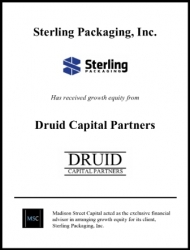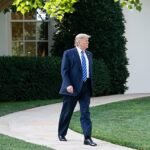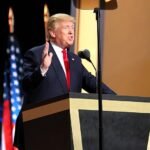Wall Street traders and everyday investors breathed a cautious sigh of relief today as U.S. stock markets posted gains, driven by optimism over President Donald Trump’s temporary pause on steep tariffs against the European Union. The rally, which saw the S&P 500 rise 1.2%, came as long-dated U.S. Treasury yields, including the 30-year bond, fell nearly 20 basis points, signaling a shift in investor sentiment after weeks of turmoil sparked by Trump’s trade policies. For families with retirement accounts and businesses reliant on global trade, the market’s response offered a moment of hope amid ongoing economic uncertainty.
The surge followed Trump’s announcement over the weekend, after a call with the European Commission’s president, to delay a proposed 50% tariff on EU goods until July 9. This pause, excluding China where tariffs rose to 145%, eased fears of a broader trade war that had rattled markets in April. The Dow Jones Industrial Average climbed 0.8%, while the Nasdaq gained 1.5%, reflecting confidence in technology and defense sectors. Long-dated Treasury yields, which hit a peak of 5.02% in April, dropped to 4.715% for the 30-year bond, marking the largest single-day decline since mid-April, as investors reconsidered the risks of U.S. debt.
For individuals like Maria Lopez, a Maryland retiree with a 401(k) tied to the S&P 500, the market’s recovery brought cautious optimism. “I was terrified watching my savings drop last month,” she said. “This uptick feels like a break, but I’m still worried about what comes next.” Businesses, too, felt the strain of tariff uncertainty. A New Jersey-based importer, John Carter, noted that April’s tariff threats disrupted his supply chain, forcing him to delay orders. “The pause helps, but we need clarity,” he said.
The context of Trump’s tariff policies is rooted in his April 2 announcement of “reciprocal” tariffs on dozens of countries, which triggered a sharp sell-off in stocks and bonds. The 10-year Treasury yield soared from 3.9% to 4.5%, an unusually large move that raised borrowing costs for mortgages and business loans, squeezing consumers like Lopez and entrepreneurs like Carter. The bond market’s volatility, driven by fears of inflation and a potential U.S. recession, prompted Trump’s April 9 decision to pause most tariffs for 90 days, a move he attributed to watching a “queasy” bond market. Economists note that the falling dollar and rising yields signaled a rare loss of confidence in U.S. assets, traditionally seen as safe havens.
Reactions reflect a mix of relief and caution. “The market’s seeing this pause as a chance to recalibrate,” said Laura Friedman, a financial analyst in New York. “But the China tariffs keep everyone on edge.” Federal Reserve Chair Jerome Powell, speaking at a recent conference, warned that sustained tariffs could drive inflation to 4.5% by 2026, impacting families’ grocery bills and housing costs. Small business owners, like Carter, expressed frustration over the lack of clear trade policies, while investors like Lopez hope for stability to protect their nest eggs.
The implications are significant for American households and businesses. Lower bond yields could ease mortgage rates, offering relief to first-time homebuyers like Sarah Kim in Baltimore, who postponed her home purchase when rates spiked. However, the ongoing U.S.-China trade dispute, with China’s retaliatory 125% tariffs on American goods, threatens industries like agriculture and manufacturing, potentially raising prices for consumers. The Federal Reserve faces pressure to hold interest rates steady at 4.25–4.5%, balancing inflation risks against recession fears.
Looking ahead, investors await Nvidia’s earnings report and the U.S. core PCE price index, which could clarify inflation trends. Trump’s July 9 deadline for EU tariff negotiations looms, with no clear resolution for China’s escalating trade war. For families and businesses, the uncertainty underscores the human stakes of policy swings. As Lopez put it, “I just want to know my savings are safe.” The market’s next moves will depend on whether Trump’s team can stabilize trade relations without reigniting bond market fears.


















